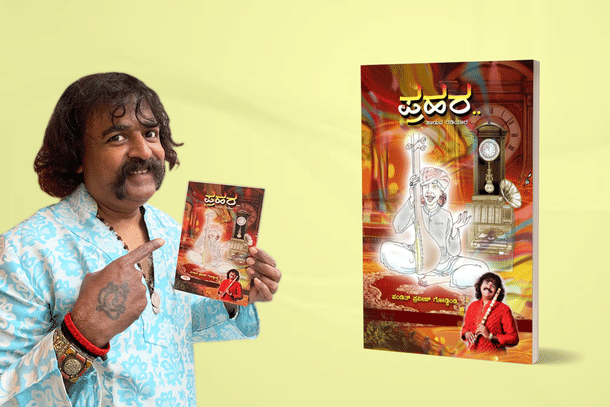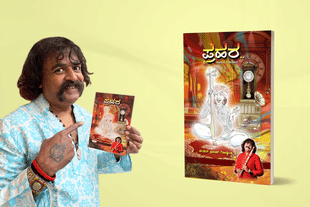Books
This Time, It Is Pravin’s Pen That Takes On For A Melodious Work
Ranjani Govind
Apr 08, 2022, 12:10 PM | Updated 12:58 PM IST
Save & read from anywhere!
Bookmark stories for easy access on any device or the Swarajya app.


We are used to flautist Pravin Godkhindi throwing surprises, and this time he turned an author with his first book in Kannada launched in Bengaluru recently. ‘Prahara -- Haduva Gadiyara’ champions the therapeutic values intrinsic to ragas and how the singing clock developed by the hero in the novel tries to look at music to foster values in society.
“My book has everything… with music as the base, it brings out all human emotions like jealousy, happiness, sorrow and suspense,” said Pravin Godkhindi, amongst the well-known flautists of Karnataka whose first novel in Kannada ‘Prahara – Haaduva Gadiyaara’ (Singing Clock) was launched in Bangaluru (Sapna Book House, Rs 120) amidst showers of praise from the music and literary world.
Some of their responses are also highlighted in the book. And why did this global musician choose to write in Kannada? “Poet and lyricist Jayant Kaikini advised me that if the original is in my mother tongue it could help being well-structured and better-thought-through,” says Godkhindi known for his classical Hindustani and fusion presentations.
He is the son of vocalist, flautist and harmonium player Venkatesh Godkhindi who established the Sanjog Bansuri Mahavidyalay in Bengaluru that has guided hundreds of students.
“As a musician in the field for four decades, it was easier to create flowing emotions. I can create a corresponding mood with my flute, or compose a tune when a situation is described to me. But as an author, a relatively new medium, the process of building a storyline with melody as its fulcrum was a fresh and innovative experience. The double challenge was in the fact that I took it up in Kannada,” says Godkhindi when asked on how he felt as an author, instead of a musician.
Kannada offers multiple options for the same meaning, and one has to proficiently structure them all, says Godkhindi whose rendezvous with the novel was a pleasant experience of “rewriting and re-phrasing his thought-flow” and finally, with the line drawings, the book gained an antique look in its design.
“Responses from luminaries such as HS Venkateshmurthy, Jayant Kaikini, Pt Vinayak Torvi, Yashwant Sardeshpande, P Seshadri, Jogi, Surendranath and BV Srinvas amongst others in the foreword was rewarding, let’s see what the general public has to say,” he adds.
In his line of surprises
But throwing surprises is nothing new to Godkhindi though. If this book for him was the second assignment he took up in the silence of the pandemic, Pravin, who had himself turned positive to Covid-19, was determined to put his home-bound time to full use.
Earlier the flautist worked out a soothing raga series ‘Healing through #raagatainment #101ragas’ to help people not just get familiarized with melodic scales, but experience the comforting effects on their mind and soul. “I knew that anxious minds will enjoy these presentations as melody brings peace within. It’s a sphere where one can take their mind off all problems even while going through pain and suffering,” Godkhindi had said while he had chartered a list of 101 ragas to be shared in a year with music connoisseurs, twice a week online.
He did this specifically to educate the younger generation about the rich classical music heritage in India. And his hundredth raga was yet another surprise to people when he took up his father Venkatesh Godkhindi’s creation ‘Sanjog’ as a commemoration to him. ‘Sanjog’ is a combination of the scales Rageshri and Malkauns with lilting elements of Jog sprinkled in it.
And who can forget how he astonished people in 2015 with his play on the world’s largest flute, Contrabass? He had come across this wonder at the World Flute Festival that had a bass sound! Fascinated with the PVC pipe flute, he sourced one and worked on it for 30 months to bring elements of Indian melody on it devising newer methods of glides and dhamak on it that is crucial to Indian melody.
Journey with the pen
What was Godkhindi’s inspiration to exchange his flute with a pen for a while in ‘Prahara-Haduva Gadiyara’? “My experience as a musician is what inspired me throughout my musical journey. I have thrown extensive light on ragas during my concerts. While I grew up in Dharwad and have distinct memories of listening to Gangubai Hangal, Basavaraj Rajguru, and Pt Bhimsen Joshi, my father regularly spoke about many legendary musicians, their stories and experiences. And my great-grandfather was a playwright and songwriter, so writing has also been in our family,” he says.
Since the book is set in Dharwad and Hubballi, the Uttara Kannada dialect comes cross. It is based on the Prahara system of Hindustani music. One Prahara is equal to three hours. There are four in the day starting at 6am and four in the night starting at 6pm.
“I was used to these time schedules for taking up ragas from my childhood, just as other musicians too followed this Prahara or the Raga-time system. In my book the main character, Pt Shardaprasad Ramdurgi is striving hard to share his thoughts on the therapeutic value that each raga is built up with. He builds a clock along with an inter-connected jukebox. There are 24 LPs of his own recordings. So, 24 ragas are played in succession in a day at the stroke of each hour. As the novel is set in the 50s and 60s when tape recorders and batteries were not known in villages, Ramdurgi wants to spread the scent of classical music to see a culturally-rich society. He wants people to use the clock he has invented to understand the essence of ragas and celebrate the vibes of Hindustani music,” explains Godkhindi.
The book is not just a read as a novel but useful for students too. “The work will also double-up to becoming a reference material to students in their music study,” he says. “I have described the possible 24 ragas of a day, explaining some indispensable terminologies used in music and the intricate and nuanced musicality present in those times.
What makes the work engaging are all the elements of a novel coming together. With music as its focal point, the storyline goes beyond ragas to have a musical face-off between two musicians, while a love story is correspondingly shaping up with a detailing on ragas. “The drive was to have a man's passion for music coming out,” says Godkhindi.
Concert at Sree Ramaseva Mandali, Old Fort High School Grounds
Ask Pravin if he wants to take up a sampling of his recently concluded online series, ‘Healing through #raagatainment #101ragas,’ at his upcoming concert at Sree Ramaseva Mandali (8 April, 6.45pm) and he says, “Let’s keep that a surprise.” Will Pravin take up his father’s raga, ‘Sanjog’ on the flute for Ramanavami? Anyone’s guess…
Also Read: Ramanavami In Bengaluru: Big Banners Have Their Concerts Back On Track





